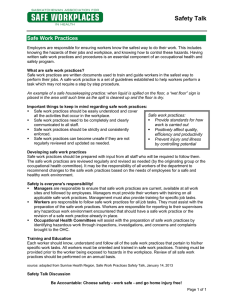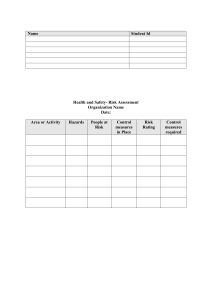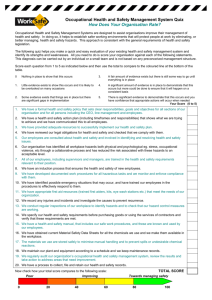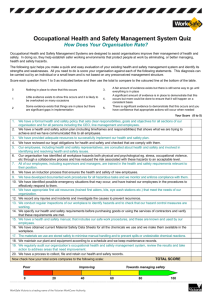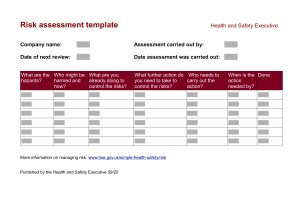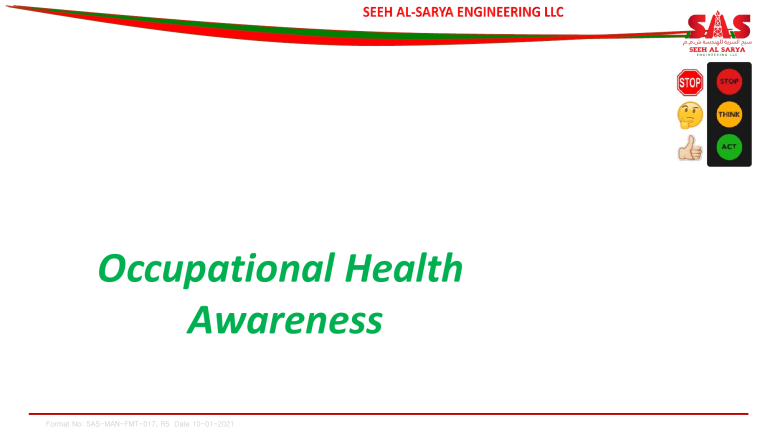
Occupational Health Awareness Format No: SAS-MAN-FMT-017, R5 Date 10-01-2021 OCCUPATIONAL HEALTH SP & SOP SP – 1231 OCCUPATIONAL HEALTH SPECIFICATIONS SAS-HSE-SOP-003 R0 SOP for Hearing Protection SAS-HSE-SOP-005 R0 SOP for PPE Management SAS-HSE-SOP-006 R0 SOP for Radiation Control SAS-HSE-SOP-023 R0 SOP for Chemical Handling Format No: SAS-MAN-FMT-017, R5 Date 10-01-2021 OCCUPATIONAL HEALTH Occupational health is the branch of medicine that deals with the identification, prevention, and treatment of health problems and injuries that are caused or worsened by work-related factors. It is concerned with the physical, chemical, biological, ergonomic, and psychological hazards that can arise in the workplace, and it aims to promote the health, safety, and well-being of employees. Occupational health involves a multidisciplinary approach that includes medical professionals, occupational safety and health specialists, engineers, and other experts who work together to identify and control workplace hazards and protect the health and safety of workers. Format No: SAS-MAN-FMT-017, R5 Date 10-01-2021 IMPORTANCE OF OCCUPATIONAL HEALTH AWARENESS Protecting the health and safety of employees: Occupational health awareness helps identify and prevent workplace hazards that can cause injury, illness, or even death. It is essential to ensure that employees work in a safe and healthy environment. Reducing healthcare costs: Work-related illnesses and injuries can lead to significant healthcare costs for employees, employers, and society as a whole. By promoting occupational health awareness, employers can reduce the incidence of work-related injuries and illnesses, which in turn can lower healthcare costs. Enhancing productivity: A safe and healthy work environment can improve employee productivity and reduce absenteeism. By promoting occupational health awareness, employers can help ensure that their employees are healthy, engaged, and motivated. Meeting legal and regulatory requirements: Employers have legal and regulatory obligations to provide a safe and healthy work environment for their employees. By promoting occupational health awareness, employers can ensure that they meet these obligations and avoid legal and financial penalties. Format No: SAS-MAN-FMT-017, R5 Date 10-01-2021 PHYSICAL HAZARDS Format No: SAS-MAN-FMT-017, R5 Date 10-01-2021 PHYSICAL HAZARDS Noise: Exposure to high levels of noise can cause hearing loss or damage, tinnitus, and other health problems. Vibrations: Prolonged exposure to vibrations, such as those from heavy machinery, can cause damage to the nerves, blood vessels, and joints. Heat: Exposure to high temperatures can cause heat exhaustion or heat stroke, which can lead to serious health problems or even death. Radiation: Exposure to ionizing radiation, such as X-rays or gamma rays, can cause DNA damage and increase the risk of cancer. Electromagnetic fields: Exposure to electromagnetic fields, such as those from power lines or electronic devices, may increase the risk of cancer or other health problems. Ergonomic hazards: These hazards can result from poor workstation design, repetitive motions, or awkward postures, and can lead to musculoskeletal disorders. Format No: SAS-MAN-FMT-017, R5 Date 10-01-2021 HEAT STRESS Heat stress occurs when the body is exposed to high temperatures for an extended period of time, which can lead to a range of negative health effects. When the body overheats, it tries to cool itself down by sweating and increasing blood flow to the skin. However, in hot and humid conditions, sweat may not evaporate easily, which can prevent the body from cooling down effectively. Some of the symptoms of heat stress can include fatigue, weakness, headache, nausea, dizziness, and muscle cramps. In more severe cases, heat exhaustion or heat stroke can occur, which can lead to serious health complications, such as organ damage, seizures, or even death. Heat stress can affect anyone, but certain groups of people are more vulnerable, including the elderly, young children, pregnant women, people with chronic health conditions, and individuals who work or exercise outdoors in hot conditions. It's important to take preventative measures, such as staying hydrated, avoiding direct sunlight, wearing light and breathable clothing, and taking frequent breaks in cool or air-conditioned areas. Format No: SAS-MAN-FMT-017, R5 Date 10-01-2021 DIESEL EXHAUST Diesel exhaust is a type of air pollution that is generated by the combustion of diesel fuel in engines. Diesel engines are commonly used in vehicles such as buses, trucks, and trains, as well as in construction equipment and generators. Diesel exhaust contains a complex mixture of gases and particles, including carbon monoxide, nitrogen oxides, particulate matter, and volatile organic compounds. Exposure to diesel exhaust can have negative health effects, particularly on the respiratory system. Short-term effects can include coughing, wheezing, and difficulty breathing, while longterm exposure can increase the risk of respiratory diseases such as asthma and lung cancer. To minimize exposure to diesel exhaust, measures such as using diesel particulate filters, reducing idling times, and using cleaner fuels or electric alternatives can be taken. It is also important to prioritize air quality in urban areas where diesel engines are commonly used, through policies such as emission standards and urban planning. Format No: SAS-MAN-FMT-017, R5 Date 10-01-2021 CHEMICAL HAZARDS Format No: SAS-MAN-FMT-017, R5 Date 10-01-2021 CHEMICAL HAZARDS Hazardous substances: This includes any substance that is harmful to health, including carcinogens, mutagens, and teratogens. Examples include lead, asbestos, benzene, and mercury. Gases: Some gases, such as carbon monoxide, chlorine, and ammonia, can be toxic and can cause serious health problems or even death. Fumes: Fumes are tiny particles that are released when a substance is heated, and can cause respiratory problems and other health issues. Examples include welding fumes and diesel exhaust fumes. Solvents: Solvents are chemicals used to dissolve other substances, and can be harmful if inhaled or absorbed through the skin. Examples include paint thinners, cleaning agents, and degreasers. Pesticides: Pesticides are chemicals used to control pests, and can be harmful if not used correctly. Exposure to pesticides can cause health problems such as cancer, reproductive problems, and neurological disorders. Format No: SAS-MAN-FMT-017, R5 Date 10-01-2021 BIOLOGICAL HAZARDS Format No: SAS-MAN-FMT-017, R5 Date 10-01-2021 BIOLOGICAL HAZARDS Viruses: Viruses are infectious agents that can cause a range of illnesses, from the common cold to more serious diseases such as HIV/AIDS and COVID-19. Bacteria: Bacteria are single-celled organisms that can cause infections, such as tuberculosis and meningitis. Fungi: Fungi are organisms that can cause infections, allergies, and other health problems, such as athlete's foot and ringworm. Parasites: Parasites are organisms that live on or inside another organism and can cause disease, such as malaria and toxoplasmosis. Biohazardous waste: This includes medical waste, such as used needles and infectious materials, which can spread disease if not handled and disposed of properly. Format No: SAS-MAN-FMT-017, R5 Date 10-01-2021 ERGONOMIC HAZARDS Format No: SAS-MAN-FMT-017, R5 Date 10-01-2021 ERGONOMIC HAZARDS • Ergonomic hazards refer to factors or conditions in the workplace that can cause musculoskeletal disorders or other health problems related to poor ergonomic design. Some examples of ergonomic hazards include: Poor posture: Prolonged sitting or standing in awkward positions can cause strain on the muscles, tendons, and ligaments, leading to musculoskeletal disorders such as back pain and carpal tunnel syndrome. Repetitive motions: Performing the same motion over and over again, such as typing or assembly line work, can cause strain on the muscles and tendons, leading to musculoskeletal disorders. Forceful exertions: Exerting excessive force, such as lifting heavy objects, can cause injury to the muscles, tendons, and ligaments, leading to musculoskeletal disorders. Awkward postures: Working in awkward or uncomfortable positions, such as reaching or bending over, can cause strain on the muscles, tendons, and ligaments, leading to musculoskeletal disorders. Format No: SAS-MAN-FMT-017, R5 Date 10-01-2021 PSYCHOLOGICAL HAZARDS Format No: SAS-MAN-FMT-017, R5 Date 10-01-2021 PSYCHOLOGICAL HAZARDS • Psychological hazards refer to factors or conditions in the workplace that can cause psychological harm or injury to employees. Some examples of psychological hazards include: Work-related stress: High workload, job insecurity, and lack of control can cause workrelated stress, leading to anxiety, depression, and other mental health problems. Workplace violence: Any form of violence, such as verbal or physical abuse, threats, or intimidation, can cause psychological harm or trauma to employees. Bullying and harassment: Any form of bullying, harassment, or discrimination based on race, gender, or other factors can cause psychological harm to employees, leading to anxiety, depression, and other mental health problems. Trauma: Exposure to traumatic events, such as workplace accidents or incidents, can cause psychological harm or trauma to employees. Format No: SAS-MAN-FMT-017, R5 Date 10-01-2021 OCCUPATIONAL HEALTH HAZARDS - SHORT-TERM EFFECTS Format No: SAS-MAN-FMT-017, R5 Date 10-01-2021 OCCUPATIONAL HEALTH HAZARDS - SHORT-TERM EFFECTS Injuries: Physical hazards, such as slips, falls, and cuts, can cause immediate injuries that require medical attention. For instance, exposure to sharp objects or machinery can lead to cuts, lacerations, or even amputations. Burns: Exposure to thermal hazards, such as heat and flames, can cause burns that require immediate medical attention. For instance, exposure to chemicals or flammable substances can cause burns or explosions that can injure employees. Respiratory problems: Exposure to chemical and biological hazards can cause respiratory problems, such as asthma and bronchitis, which can cause shortness of breath, coughing, and wheezing. Allergic reactions: Exposure to certain chemicals or biological hazards can cause allergic reactions, such as skin rashes, hives, and swelling. Acute illnesses: Exposure to infectious agents, such as bacteria and viruses, can cause acute illnesses, such as the flu and food poisoning, which can cause fever, diarrhea, and vomiting. Format No: SAS-MAN-FMT-017, R5 Date 10-01-2021 OCCUPATIONAL HEALTH HAZARDS - LONG-TERM EFFECTS Format No: SAS-MAN-FMT-017, R5 Date 10-01-2021 OCCUPATIONAL HEALTH HAZARDS - LONG-TERM EFFECTS Occupational cancers: Exposure to carcinogens, such as asbestos and radiation, can cause various types of cancer, including lung cancer and skin cancer. Reproductive problems: Exposure to chemical and biological hazards can cause reproductive problems, such as infertility, miscarriages, and birth defects. Musculoskeletal disorders: Ergonomic hazards, such as poor posture and repetitive motions, can cause musculoskeletal disorders, such as carpal tunnel syndrome and chronic back pain. Mental health problems: Exposure to psychological hazards, such as workplace violence and work-related stress, can cause mental health problems, such as depression, anxiety, and post-traumatic stress disorder (PTSD). Format No: SAS-MAN-FMT-017, R5 Date 10-01-2021 PREVENTIVE MEASURES ENGINEERING CONTROLS Format No: SAS-MAN-FMT-017, R5 Date 10-01-2021 PREVENTIVE MEASURES ENGINEERING CONTROLS Ventilation systems: Proper ventilation can help control exposure to hazardous gases, fumes, and dust. Employers can use local exhaust ventilation systems, such as hoods and ducts, to capture and remove contaminants from the air. Noise reduction: Employers can use sound-absorbing materials, such as barriers and panels, to reduce noise levels in the workplace. They can also use noise-reducing technologies, such as mufflers and silencers, on equipment that generates loud noises. Enclosures and barriers: Employers can use physical barriers, such as walls and shields, to separate employees from hazardous equipment or materials. Enclosures can also be used to contain hazardous materials, such as chemicals or radiation. Substitution: Employers can replace hazardous materials or equipment with less hazardous alternatives. For instance, they can use non-toxic cleaning products or replace chemical solvents with water-based alternatives. Automation: Employers can use automated equipment or robotics to perform tasks that are hazardous or repetitive, reducing the risk of injuries and illnesses. Format No: SAS-MAN-FMT-017, R5 Date 10-01-2021 ADMINISTRATIVE CONTROLS Work schedules: modify work schedules to reduce employee exposure to hazards. For instance, they can implement job rotation or work schedule changes to reduce the amount of time employees spend in hazardous environments. Training and education: provide employees with training and education on hazard awareness, safe work practices, and the proper use of personal protective equipment (PPE). Standard operating procedures: develop standard operating procedures (SOPs) to outline safe work practices and hazard control measures. SOPs should be regularly updated and communicated to employees. Job hazard analysis: conduct a job hazard analysis (JHA) to identify hazards associated with specific job tasks. JHA can help employers develop hazard control measures and provide employees with job-specific hazard awareness and training. Workplace policies: develop workplace policies that promote a culture of safety and health, such as policies on workplace violence prevention, substance abuse, and fatigue management. Format No: SAS-MAN-FMT-017, R5 Date 10-01-2021 PERSONAL PROTECTIVE EQUIPMENT (PPE) Format No: SAS-MAN-FMT-017, R5 Date 10-01-2021 PERSONAL PROTECTIVE EQUIPMENT (PPE) Respirators: Employers can provide respirators to protect employees from breathing in hazardous materials, such as dust, fumes, and gases. Gloves: Employers can provide gloves to protect employees from exposure to hazardous substances, such as chemicals and biological agents. Safety glasses: Employers can provide safety glasses to protect employees from eye injuries caused by flying objects, chemicals, or radiation. Hard hats: Employers can provide hard hats to protect employees from head injuries caused by falling objects or electrical hazards. Hearing protection: Employers can provide hearing protection, such as earplugs or earmuffs, to protect employees from noise-induced hearing loss. Format No: SAS-MAN-FMT-017, R5 Date 10-01-2021 SUMMARY In summary, occupational health hazards pose a significant risk to the health and wellbeing of employees, and employers have a responsibility to provide a safe and healthy work environment. The types of occupational health hazards include physical, chemical, biological, ergonomic, and psychological hazards, and they can result in short-term and long-term health effects. Preventive measures include engineering controls, administrative controls, personal protective equipment, and workplace policies and programs. Employers and employees have legal and ethical responsibilities to ensure the privacy and confidentiality of personal health information and to create a culture of safety and respect in the workplace. Overall, by working together and fulfilling their responsibilities, employers and employees can promote occupational health and well-being and create a safe and productive work environment. Format No: SAS-MAN-FMT-017, R5 Date 10-01-2021 Format No: SAS-MAN-FMT-017, R5 Date 10-01-2021
